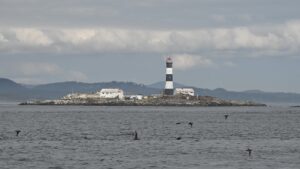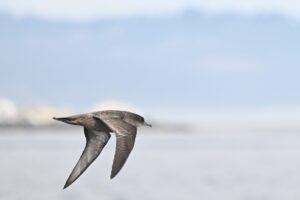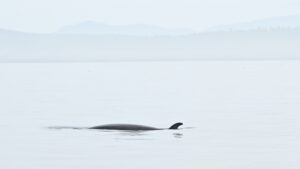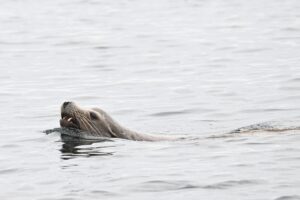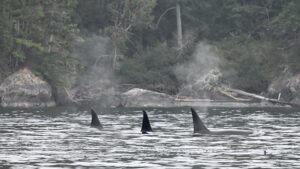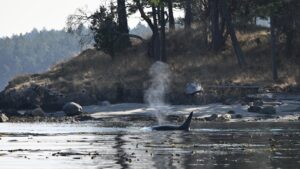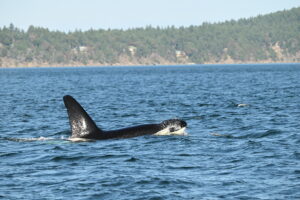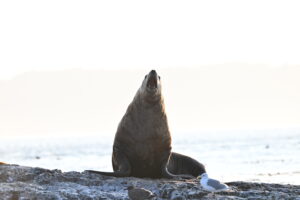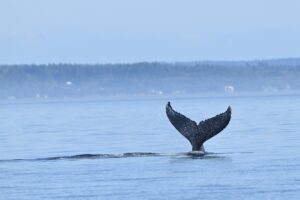While out on tours this past week we really began feeling some fall chill in the air (cue adding more layers to the ensemble). Even on the cusp of the season change we have continued to have whale encounters on each of our tours, mainly Bigg’s killer whales (marine-mammal eaters), some humpbacks, and a couple Minke whales. We will especially savor our baleen whale encounters while we have them, as migration is right around the corner for those whales. And who wouldn’t want to move on to warm, tropical waters for some time?
Before I get into our whale recap for this week–we had a Blue Kingdom Tours first ever sighting of a black bear on the south end of Vancouver Island this past week! It was a fleeting look, as the bear was making it’s way from the intertidal up into the wooded area, but a jaw-droppingly unexpected moment, for sure!
Bigg’s killer whale families that were encountered on our tours this week were: T19s (3), T36A1s (2) with T99B (1), T46B1s with T46C2, brothers T60D & T60E (2), T69E, T75Bs (5), the rest of the T99s (4), and the T137s (4) making for a total of 25 individuals sighted. What was notable and interesting this past week was that the T60 brothers briefly met up and traveled with T69E, making for a social trio of adult males. After naturalizing all season with orca mothers and their offspring as the central focus of most of what I share, it was really cool to switch things up a bit. Of course, the “oohs” and “ahhs” that come from watching those large dorsal fins break the surface always make my heart smile, as well.
We had a trip that took us west out into the Strait of Juan de Fuca near Race Rocks, and this ecological reserve was really hopping with wildlife! Due to that trip alone, our humpback whale encounters were markedly up this week. Of the 5 whales we saw on that trip, only one fluked (showing the underside of the tail) to reveal their identity. This humpback whale was BCX1876 “Zillion.” We continued to have encounters with BCZ0345 “Victory” in some of her usual spots–banks off of the south end of Lopez and San Juan Island; on two occasions, she was actively lunge feeding sending lots of gulls into the air in a tizzy. And finally, we encountered two humpback whales traveling together in Boundary Pass near Turn Point that turned out to be BCZ0155 “Manta,” a male that has been matched to Hawaiian AND Mexican breeding grounds, and BCX1675 “Strike,” a female whale also matched to Mexican breeding grounds. It had me wondering if perhaps they know each other from those waters down in lower latitudes, or was it just happenstance that they were traveling together for the afternoon? So many questions we’ll never truly have answers for.
Minke whales continue to cruise around Salmon Bank, Middle Bank, and Hein Bank and were seen on several of our tours this week. Those whales are focused on feeding before they also slip away to unknown breeding grounds at lower latitudes, where breeding and birthing occur.
Some seabird fun was had (mostly by me, but also be a few bird-nerdy guests). Short-tailed shearwaters often show up in small groups in the fall, but out near Race Rocks you’d think they were common and regulars! These true pelagic species (only coming to land to breed and nest) have very snappy wingbeats and glide just above the water–a much different movement than gulls and other seabirds. We’ve also seen little groupings of red-necked phalaropes and the occasional parasitic jaeger. Some juvenile brown pelicans, which are typically only found along the coast of Washington, were hanging out in Rosario Strait and at bird rocks. And we may have also seen the last of the Tufted Puffins out near Smith Island. The two individuals sighted barely had any of their tufts left, yet another sign that change is on the horizon. They will push out to open ocean and winter out there until the urge to breed brings them in again next year (late April, early May).
In all, it was a great week, and as always, we are looking forward to seeing what the next week of wildlife sightings is going to bring us.

